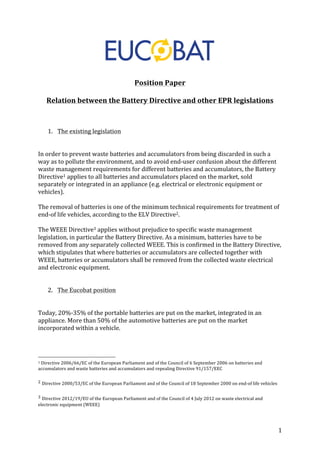
Recycling Capacity and Requirements
- 1. 1 Position Paper Relation between the Battery Directive and other EPR legislations 1. The existing legislation In order to prevent waste batteries and accumulators from being discarded in such a way as to pollute the environment, and to avoid end-‐user confusion about the different waste management requirements for different batteries and accumulators, the Battery Directive1 applies to all batteries and accumulators placed on the market, sold separately or integrated in an appliance (e.g. electrical or electronic equipment or vehicles). The removal of batteries is one of the minimum technical requirements for treatment of end-‐of life vehicles, according to the ELV Directive2. The WEEE Directive3 applies without prejudice to specific waste management legislation, in particular the Battery Directive. As a minimum, batteries have to be removed from any separately collected WEEE. This is confirmed in the Battery Directive, which stipulates that where batteries or accumulators are collected together with WEEE, batteries or accumulators shall be removed from the collected waste electrical and electronic equipment. 2. The Eucobat position Today, 20%-‐35% of the portable batteries are put on the market, integrated in an appliance. More than 50% of the automotive batteries are put on the market incorporated within a vehicle. 1 Directive 2006/66/EC of the European Parliament and of the Council of 6 September 2006 on batteries and accumulators and waste batteries and accumulators and repealing Directive 91/157/EEC 2 Directive 2000/53/EC of the European Parliament and of the Council of 18 September 2000 on end-‐of life vehicles 3 Directive 2012/19/EU of the European Parliament and of the Council of 4 July 2012 on waste electrical and electronic equipment (WEEE)
- 2. Given the specificity of batteries and their chemical composition, and in order to ensure high environmental and safety standards, it is required that all batteries are removed from WEEE and end-‐of life vehicles. This is the only way to guarantee that all batteries will be recycled according to the recycling efficiency provisions for batteries. It is therefore of the utmost importance that all batteries and all waste batteries are regulated by the Battery Directive, and that they are not considered as components, sub-‐ assemblies, accessories or consumables of (W)EEE or (end-‐of life) vehicles. 2 3. About Eucobat Eucobat is the European association of national collection schemes for batteries. They ensure that all waste batteries are collected and recycled in an ecologically sound way, and by doing so contribute to a better environment. Eucobat aisbl September 2014
